Managing Contemporary Organization Essay: Leadership Analysis
VerifiedAdded on 2023/01/23
|12
|3480
|65
Essay
AI Summary
This essay delves into key aspects of managing contemporary organizations, addressing three critical questions. Firstly, it examines teamwork as a managerial strategy for work intensification, defining teams, exploring different types, and discussing relevant theories. The essay analyzes how teamwork can be a tool to enhance productivity, considering its implications and potential drawbacks. Secondly, it explores the relationship between organizational and team climate and performance, analyzing how elements of climate, as defined by Ekvall et al., drive innovation and creativity within an organization, supported by Maslow's motivation theory. Lastly, it critically evaluates the classical approach to understanding organizational politics, providing examples and drawing conclusions on its validity. The essay integrates various perspectives and theories to offer a comprehensive analysis of contemporary management challenges and strategies, making it a valuable resource for students studying leadership and organizational behavior.

Running head: MANAGING COMTEMPORARY ORGANZIATION
MANAGING COMTEMPORARY ORGANZIATION
Student’s Name
University Name
Author note
MANAGING COMTEMPORARY ORGANZIATION
Student’s Name
University Name
Author note
Paraphrase This Document
Need a fresh take? Get an instant paraphrase of this document with our AI Paraphraser
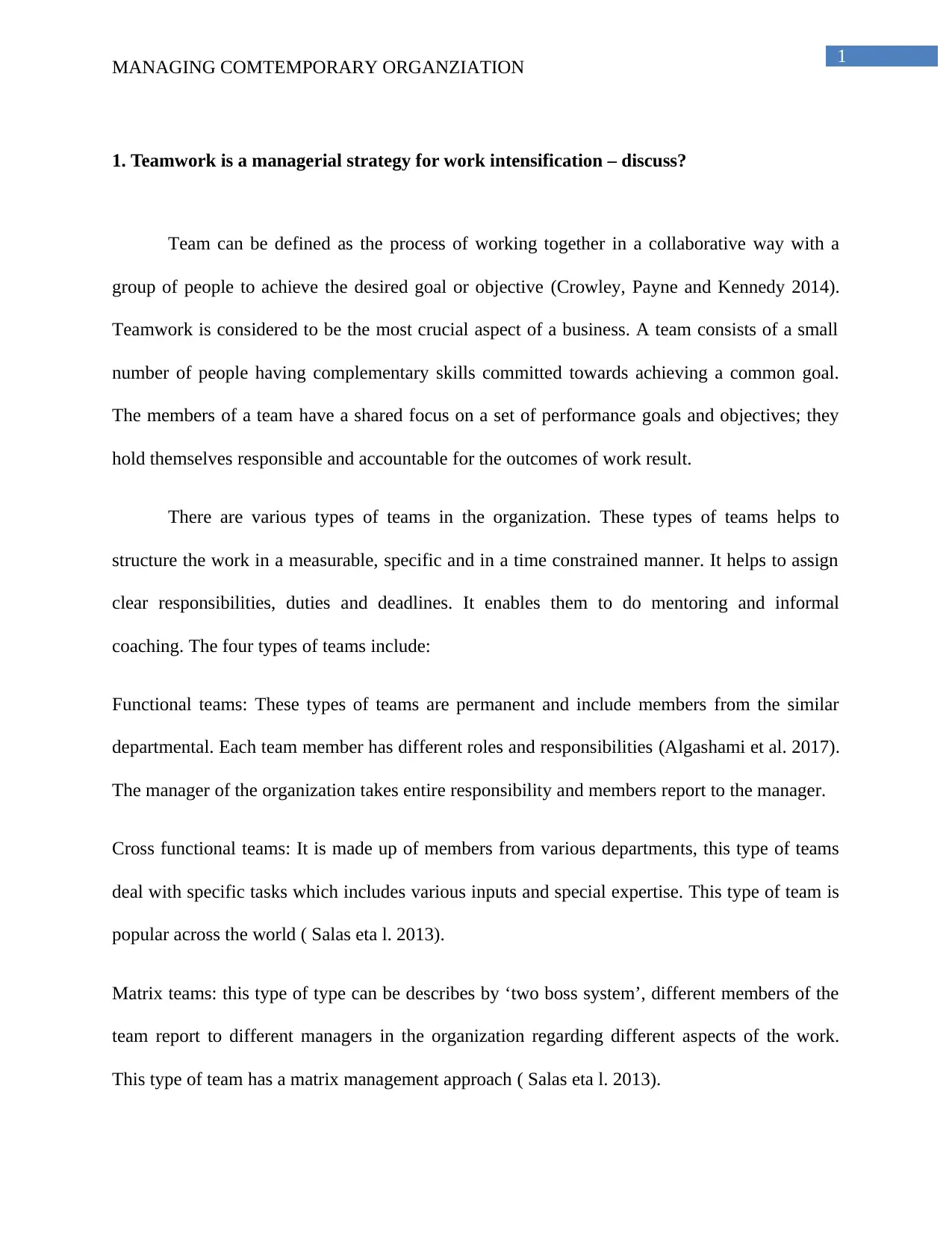
1
MANAGING COMTEMPORARY ORGANZIATION
1. Teamwork is a managerial strategy for work intensification – discuss?
Team can be defined as the process of working together in a collaborative way with a
group of people to achieve the desired goal or objective (Crowley, Payne and Kennedy 2014).
Teamwork is considered to be the most crucial aspect of a business. A team consists of a small
number of people having complementary skills committed towards achieving a common goal.
The members of a team have a shared focus on a set of performance goals and objectives; they
hold themselves responsible and accountable for the outcomes of work result.
There are various types of teams in the organization. These types of teams helps to
structure the work in a measurable, specific and in a time constrained manner. It helps to assign
clear responsibilities, duties and deadlines. It enables them to do mentoring and informal
coaching. The four types of teams include:
Functional teams: These types of teams are permanent and include members from the similar
departmental. Each team member has different roles and responsibilities (Algashami et al. 2017).
The manager of the organization takes entire responsibility and members report to the manager.
Cross functional teams: It is made up of members from various departments, this type of teams
deal with specific tasks which includes various inputs and special expertise. This type of team is
popular across the world ( Salas eta l. 2013).
Matrix teams: this type of type can be describes by ‘two boss system’, different members of the
team report to different managers in the organization regarding different aspects of the work.
This type of team has a matrix management approach ( Salas eta l. 2013).
MANAGING COMTEMPORARY ORGANZIATION
1. Teamwork is a managerial strategy for work intensification – discuss?
Team can be defined as the process of working together in a collaborative way with a
group of people to achieve the desired goal or objective (Crowley, Payne and Kennedy 2014).
Teamwork is considered to be the most crucial aspect of a business. A team consists of a small
number of people having complementary skills committed towards achieving a common goal.
The members of a team have a shared focus on a set of performance goals and objectives; they
hold themselves responsible and accountable for the outcomes of work result.
There are various types of teams in the organization. These types of teams helps to
structure the work in a measurable, specific and in a time constrained manner. It helps to assign
clear responsibilities, duties and deadlines. It enables them to do mentoring and informal
coaching. The four types of teams include:
Functional teams: These types of teams are permanent and include members from the similar
departmental. Each team member has different roles and responsibilities (Algashami et al. 2017).
The manager of the organization takes entire responsibility and members report to the manager.
Cross functional teams: It is made up of members from various departments, this type of teams
deal with specific tasks which includes various inputs and special expertise. This type of team is
popular across the world ( Salas eta l. 2013).
Matrix teams: this type of type can be describes by ‘two boss system’, different members of the
team report to different managers in the organization regarding different aspects of the work.
This type of team has a matrix management approach ( Salas eta l. 2013).
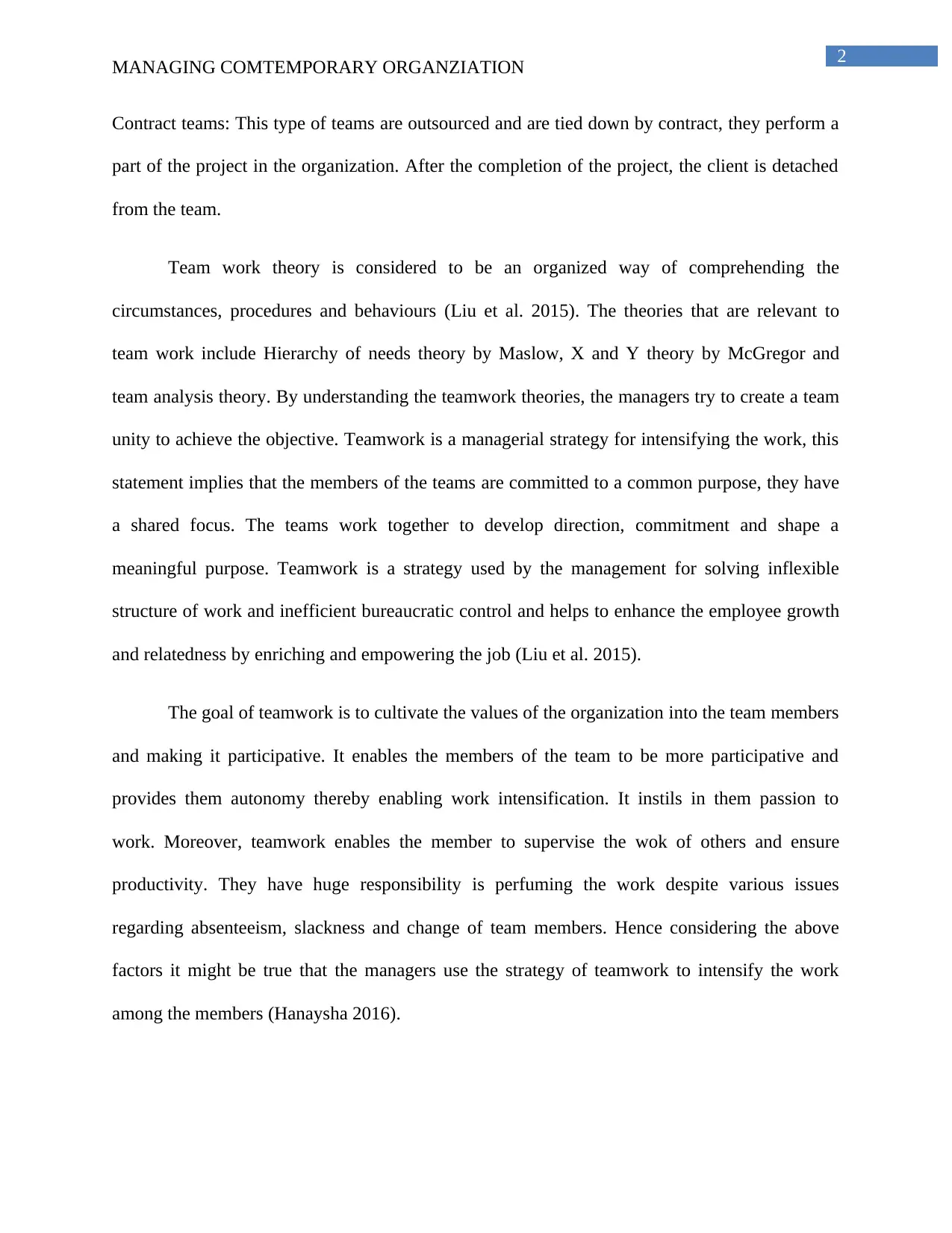
2
MANAGING COMTEMPORARY ORGANZIATION
Contract teams: This type of teams are outsourced and are tied down by contract, they perform a
part of the project in the organization. After the completion of the project, the client is detached
from the team.
Team work theory is considered to be an organized way of comprehending the
circumstances, procedures and behaviours (Liu et al. 2015). The theories that are relevant to
team work include Hierarchy of needs theory by Maslow, X and Y theory by McGregor and
team analysis theory. By understanding the teamwork theories, the managers try to create a team
unity to achieve the objective. Teamwork is a managerial strategy for intensifying the work, this
statement implies that the members of the teams are committed to a common purpose, they have
a shared focus. The teams work together to develop direction, commitment and shape a
meaningful purpose. Teamwork is a strategy used by the management for solving inflexible
structure of work and inefficient bureaucratic control and helps to enhance the employee growth
and relatedness by enriching and empowering the job (Liu et al. 2015).
The goal of teamwork is to cultivate the values of the organization into the team members
and making it participative. It enables the members of the team to be more participative and
provides them autonomy thereby enabling work intensification. It instils in them passion to
work. Moreover, teamwork enables the member to supervise the wok of others and ensure
productivity. They have huge responsibility is perfuming the work despite various issues
regarding absenteeism, slackness and change of team members. Hence considering the above
factors it might be true that the managers use the strategy of teamwork to intensify the work
among the members (Hanaysha 2016).
MANAGING COMTEMPORARY ORGANZIATION
Contract teams: This type of teams are outsourced and are tied down by contract, they perform a
part of the project in the organization. After the completion of the project, the client is detached
from the team.
Team work theory is considered to be an organized way of comprehending the
circumstances, procedures and behaviours (Liu et al. 2015). The theories that are relevant to
team work include Hierarchy of needs theory by Maslow, X and Y theory by McGregor and
team analysis theory. By understanding the teamwork theories, the managers try to create a team
unity to achieve the objective. Teamwork is a managerial strategy for intensifying the work, this
statement implies that the members of the teams are committed to a common purpose, they have
a shared focus. The teams work together to develop direction, commitment and shape a
meaningful purpose. Teamwork is a strategy used by the management for solving inflexible
structure of work and inefficient bureaucratic control and helps to enhance the employee growth
and relatedness by enriching and empowering the job (Liu et al. 2015).
The goal of teamwork is to cultivate the values of the organization into the team members
and making it participative. It enables the members of the team to be more participative and
provides them autonomy thereby enabling work intensification. It instils in them passion to
work. Moreover, teamwork enables the member to supervise the wok of others and ensure
productivity. They have huge responsibility is perfuming the work despite various issues
regarding absenteeism, slackness and change of team members. Hence considering the above
factors it might be true that the managers use the strategy of teamwork to intensify the work
among the members (Hanaysha 2016).
⊘ This is a preview!⊘
Do you want full access?
Subscribe today to unlock all pages.

Trusted by 1+ million students worldwide
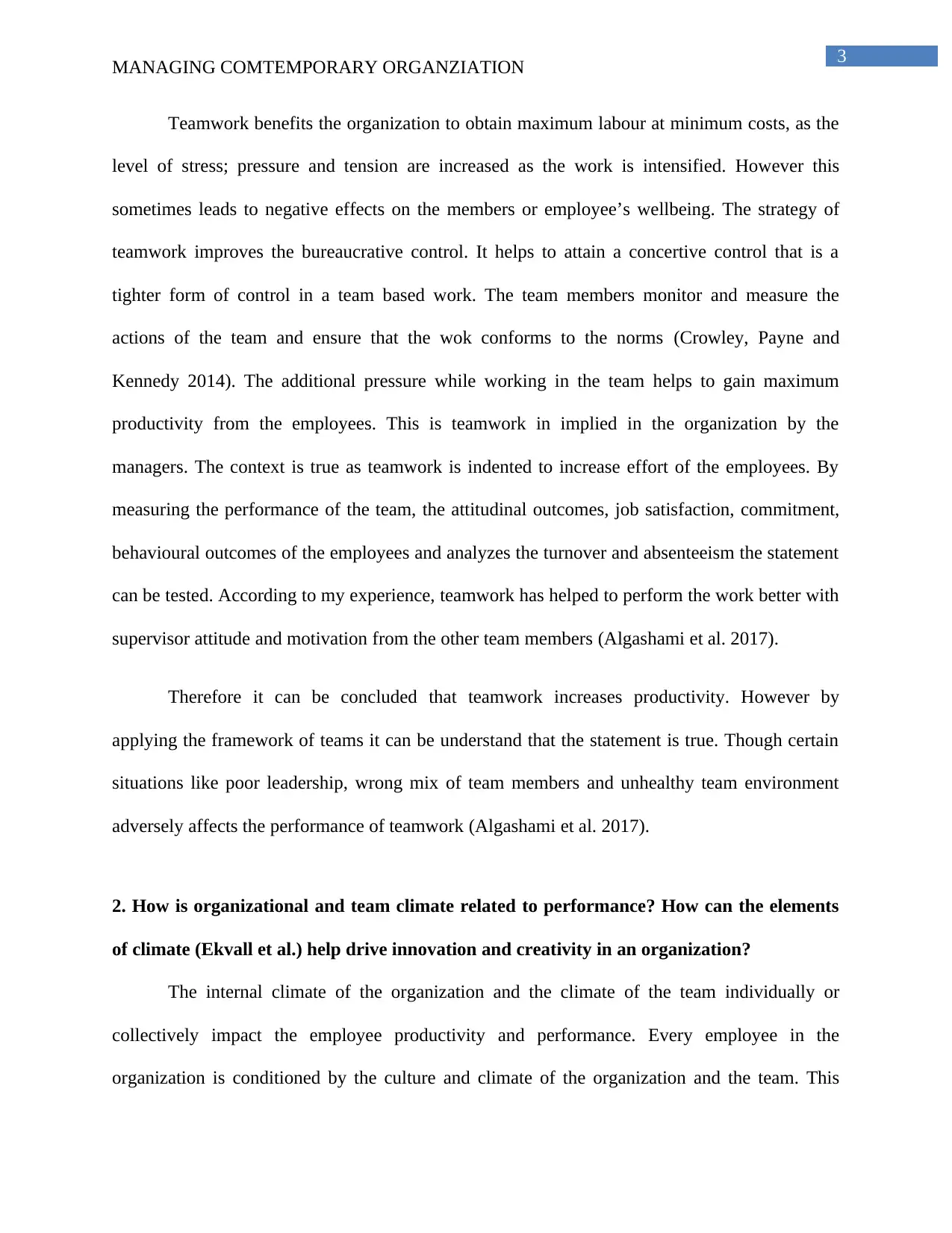
3
MANAGING COMTEMPORARY ORGANZIATION
Teamwork benefits the organization to obtain maximum labour at minimum costs, as the
level of stress; pressure and tension are increased as the work is intensified. However this
sometimes leads to negative effects on the members or employee’s wellbeing. The strategy of
teamwork improves the bureaucrative control. It helps to attain a concertive control that is a
tighter form of control in a team based work. The team members monitor and measure the
actions of the team and ensure that the wok conforms to the norms (Crowley, Payne and
Kennedy 2014). The additional pressure while working in the team helps to gain maximum
productivity from the employees. This is teamwork in implied in the organization by the
managers. The context is true as teamwork is indented to increase effort of the employees. By
measuring the performance of the team, the attitudinal outcomes, job satisfaction, commitment,
behavioural outcomes of the employees and analyzes the turnover and absenteeism the statement
can be tested. According to my experience, teamwork has helped to perform the work better with
supervisor attitude and motivation from the other team members (Algashami et al. 2017).
Therefore it can be concluded that teamwork increases productivity. However by
applying the framework of teams it can be understand that the statement is true. Though certain
situations like poor leadership, wrong mix of team members and unhealthy team environment
adversely affects the performance of teamwork (Algashami et al. 2017).
2. How is organizational and team climate related to performance? How can the elements
of climate (Ekvall et al.) help drive innovation and creativity in an organization?
The internal climate of the organization and the climate of the team individually or
collectively impact the employee productivity and performance. Every employee in the
organization is conditioned by the culture and climate of the organization and the team. This
MANAGING COMTEMPORARY ORGANZIATION
Teamwork benefits the organization to obtain maximum labour at minimum costs, as the
level of stress; pressure and tension are increased as the work is intensified. However this
sometimes leads to negative effects on the members or employee’s wellbeing. The strategy of
teamwork improves the bureaucrative control. It helps to attain a concertive control that is a
tighter form of control in a team based work. The team members monitor and measure the
actions of the team and ensure that the wok conforms to the norms (Crowley, Payne and
Kennedy 2014). The additional pressure while working in the team helps to gain maximum
productivity from the employees. This is teamwork in implied in the organization by the
managers. The context is true as teamwork is indented to increase effort of the employees. By
measuring the performance of the team, the attitudinal outcomes, job satisfaction, commitment,
behavioural outcomes of the employees and analyzes the turnover and absenteeism the statement
can be tested. According to my experience, teamwork has helped to perform the work better with
supervisor attitude and motivation from the other team members (Algashami et al. 2017).
Therefore it can be concluded that teamwork increases productivity. However by
applying the framework of teams it can be understand that the statement is true. Though certain
situations like poor leadership, wrong mix of team members and unhealthy team environment
adversely affects the performance of teamwork (Algashami et al. 2017).
2. How is organizational and team climate related to performance? How can the elements
of climate (Ekvall et al.) help drive innovation and creativity in an organization?
The internal climate of the organization and the climate of the team individually or
collectively impact the employee productivity and performance. Every employee in the
organization is conditioned by the culture and climate of the organization and the team. This
Paraphrase This Document
Need a fresh take? Get an instant paraphrase of this document with our AI Paraphraser
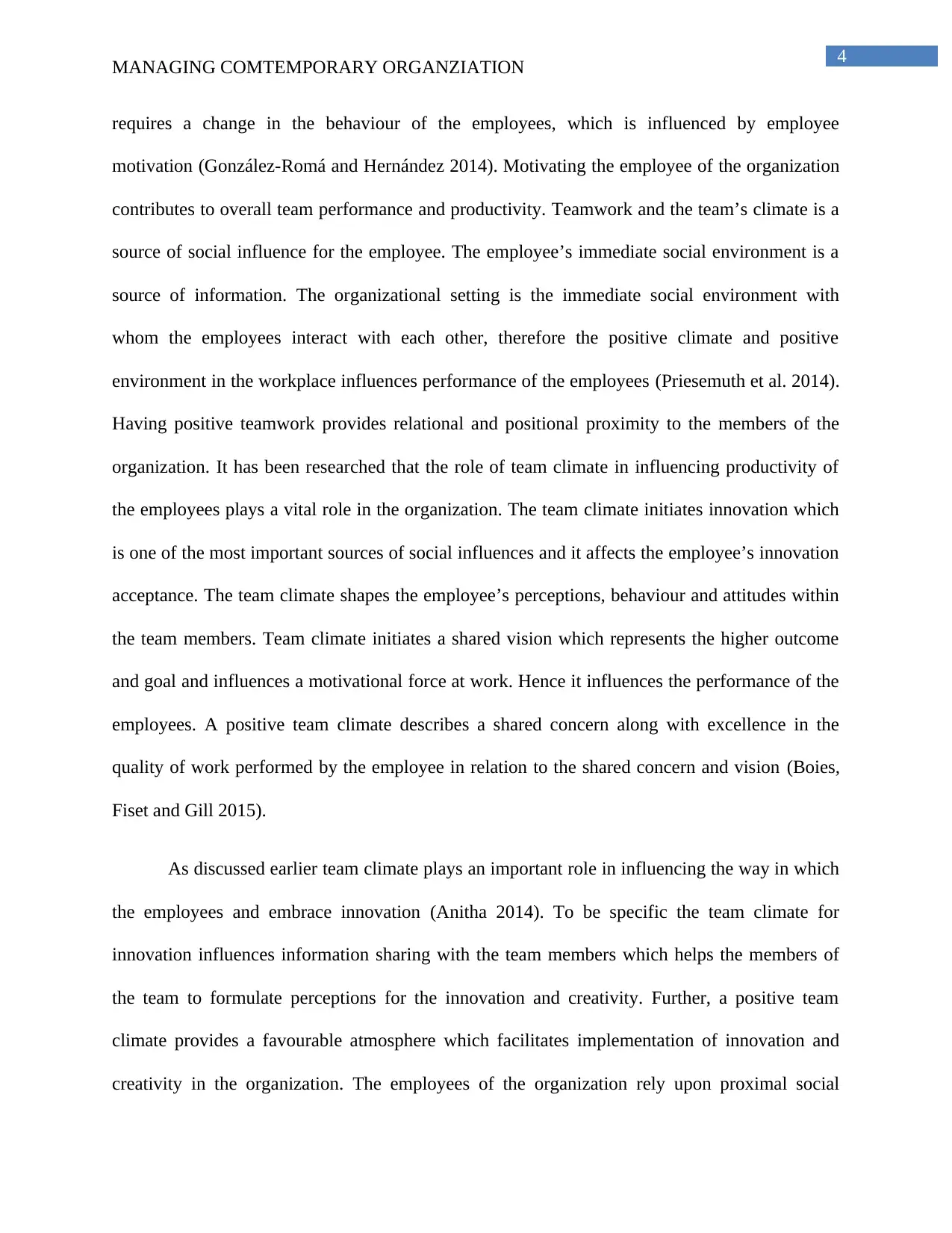
4
MANAGING COMTEMPORARY ORGANZIATION
requires a change in the behaviour of the employees, which is influenced by employee
motivation (González-Romá and Hernández 2014). Motivating the employee of the organization
contributes to overall team performance and productivity. Teamwork and the team’s climate is a
source of social influence for the employee. The employee’s immediate social environment is a
source of information. The organizational setting is the immediate social environment with
whom the employees interact with each other, therefore the positive climate and positive
environment in the workplace influences performance of the employees (Priesemuth et al. 2014).
Having positive teamwork provides relational and positional proximity to the members of the
organization. It has been researched that the role of team climate in influencing productivity of
the employees plays a vital role in the organization. The team climate initiates innovation which
is one of the most important sources of social influences and it affects the employee’s innovation
acceptance. The team climate shapes the employee’s perceptions, behaviour and attitudes within
the team members. Team climate initiates a shared vision which represents the higher outcome
and goal and influences a motivational force at work. Hence it influences the performance of the
employees. A positive team climate describes a shared concern along with excellence in the
quality of work performed by the employee in relation to the shared concern and vision (Boies,
Fiset and Gill 2015).
As discussed earlier team climate plays an important role in influencing the way in which
the employees and embrace innovation (Anitha 2014). To be specific the team climate for
innovation influences information sharing with the team members which helps the members of
the team to formulate perceptions for the innovation and creativity. Further, a positive team
climate provides a favourable atmosphere which facilitates implementation of innovation and
creativity in the organization. The employees of the organization rely upon proximal social
MANAGING COMTEMPORARY ORGANZIATION
requires a change in the behaviour of the employees, which is influenced by employee
motivation (González-Romá and Hernández 2014). Motivating the employee of the organization
contributes to overall team performance and productivity. Teamwork and the team’s climate is a
source of social influence for the employee. The employee’s immediate social environment is a
source of information. The organizational setting is the immediate social environment with
whom the employees interact with each other, therefore the positive climate and positive
environment in the workplace influences performance of the employees (Priesemuth et al. 2014).
Having positive teamwork provides relational and positional proximity to the members of the
organization. It has been researched that the role of team climate in influencing productivity of
the employees plays a vital role in the organization. The team climate initiates innovation which
is one of the most important sources of social influences and it affects the employee’s innovation
acceptance. The team climate shapes the employee’s perceptions, behaviour and attitudes within
the team members. Team climate initiates a shared vision which represents the higher outcome
and goal and influences a motivational force at work. Hence it influences the performance of the
employees. A positive team climate describes a shared concern along with excellence in the
quality of work performed by the employee in relation to the shared concern and vision (Boies,
Fiset and Gill 2015).
As discussed earlier team climate plays an important role in influencing the way in which
the employees and embrace innovation (Anitha 2014). To be specific the team climate for
innovation influences information sharing with the team members which helps the members of
the team to formulate perceptions for the innovation and creativity. Further, a positive team
climate provides a favourable atmosphere which facilitates implementation of innovation and
creativity in the organization. The employees of the organization rely upon proximal social
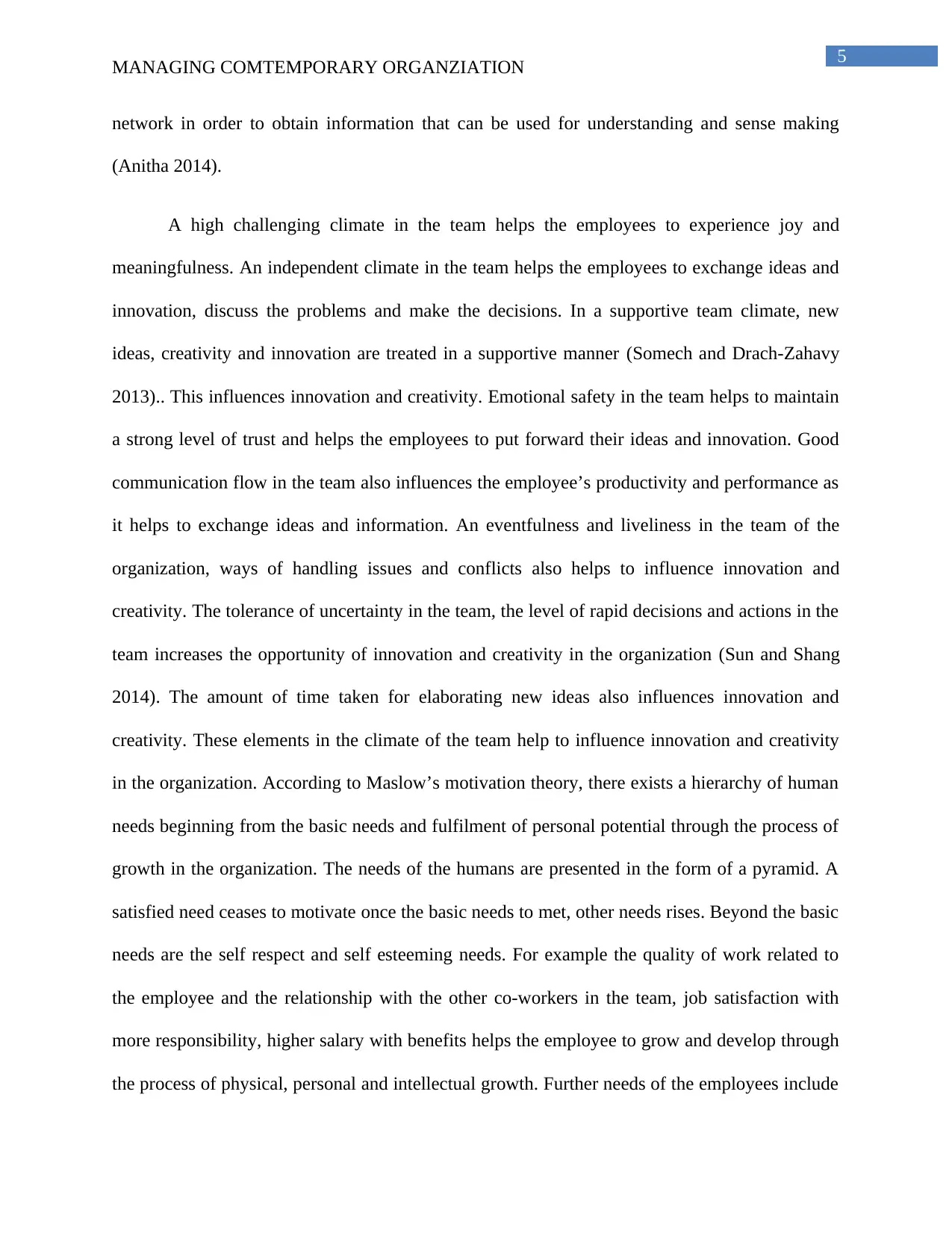
5
MANAGING COMTEMPORARY ORGANZIATION
network in order to obtain information that can be used for understanding and sense making
(Anitha 2014).
A high challenging climate in the team helps the employees to experience joy and
meaningfulness. An independent climate in the team helps the employees to exchange ideas and
innovation, discuss the problems and make the decisions. In a supportive team climate, new
ideas, creativity and innovation are treated in a supportive manner (Somech and Drach-Zahavy
2013).. This influences innovation and creativity. Emotional safety in the team helps to maintain
a strong level of trust and helps the employees to put forward their ideas and innovation. Good
communication flow in the team also influences the employee’s productivity and performance as
it helps to exchange ideas and information. An eventfulness and liveliness in the team of the
organization, ways of handling issues and conflicts also helps to influence innovation and
creativity. The tolerance of uncertainty in the team, the level of rapid decisions and actions in the
team increases the opportunity of innovation and creativity in the organization (Sun and Shang
2014). The amount of time taken for elaborating new ideas also influences innovation and
creativity. These elements in the climate of the team help to influence innovation and creativity
in the organization. According to Maslow’s motivation theory, there exists a hierarchy of human
needs beginning from the basic needs and fulfilment of personal potential through the process of
growth in the organization. The needs of the humans are presented in the form of a pyramid. A
satisfied need ceases to motivate once the basic needs to met, other needs rises. Beyond the basic
needs are the self respect and self esteeming needs. For example the quality of work related to
the employee and the relationship with the other co-workers in the team, job satisfaction with
more responsibility, higher salary with benefits helps the employee to grow and develop through
the process of physical, personal and intellectual growth. Further needs of the employees include
MANAGING COMTEMPORARY ORGANZIATION
network in order to obtain information that can be used for understanding and sense making
(Anitha 2014).
A high challenging climate in the team helps the employees to experience joy and
meaningfulness. An independent climate in the team helps the employees to exchange ideas and
innovation, discuss the problems and make the decisions. In a supportive team climate, new
ideas, creativity and innovation are treated in a supportive manner (Somech and Drach-Zahavy
2013).. This influences innovation and creativity. Emotional safety in the team helps to maintain
a strong level of trust and helps the employees to put forward their ideas and innovation. Good
communication flow in the team also influences the employee’s productivity and performance as
it helps to exchange ideas and information. An eventfulness and liveliness in the team of the
organization, ways of handling issues and conflicts also helps to influence innovation and
creativity. The tolerance of uncertainty in the team, the level of rapid decisions and actions in the
team increases the opportunity of innovation and creativity in the organization (Sun and Shang
2014). The amount of time taken for elaborating new ideas also influences innovation and
creativity. These elements in the climate of the team help to influence innovation and creativity
in the organization. According to Maslow’s motivation theory, there exists a hierarchy of human
needs beginning from the basic needs and fulfilment of personal potential through the process of
growth in the organization. The needs of the humans are presented in the form of a pyramid. A
satisfied need ceases to motivate once the basic needs to met, other needs rises. Beyond the basic
needs are the self respect and self esteeming needs. For example the quality of work related to
the employee and the relationship with the other co-workers in the team, job satisfaction with
more responsibility, higher salary with benefits helps the employee to grow and develop through
the process of physical, personal and intellectual growth. Further needs of the employees include
⊘ This is a preview!⊘
Do you want full access?
Subscribe today to unlock all pages.

Trusted by 1+ million students worldwide
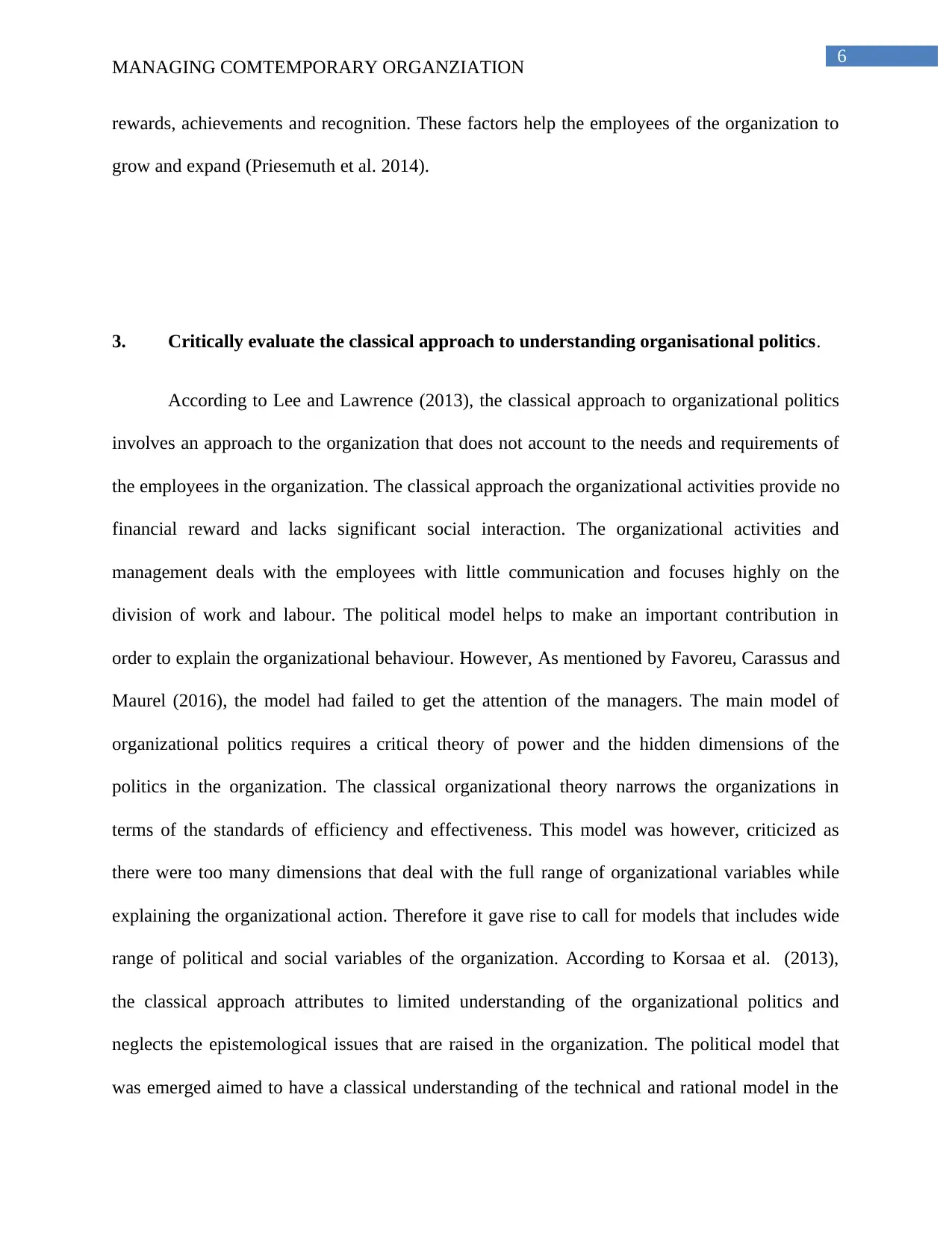
6
MANAGING COMTEMPORARY ORGANZIATION
rewards, achievements and recognition. These factors help the employees of the organization to
grow and expand (Priesemuth et al. 2014).
3. Critically evaluate the classical approach to understanding organisational politics.
According to Lee and Lawrence (2013), the classical approach to organizational politics
involves an approach to the organization that does not account to the needs and requirements of
the employees in the organization. The classical approach the organizational activities provide no
financial reward and lacks significant social interaction. The organizational activities and
management deals with the employees with little communication and focuses highly on the
division of work and labour. The political model helps to make an important contribution in
order to explain the organizational behaviour. However, As mentioned by Favoreu, Carassus and
Maurel (2016), the model had failed to get the attention of the managers. The main model of
organizational politics requires a critical theory of power and the hidden dimensions of the
politics in the organization. The classical organizational theory narrows the organizations in
terms of the standards of efficiency and effectiveness. This model was however, criticized as
there were too many dimensions that deal with the full range of organizational variables while
explaining the organizational action. Therefore it gave rise to call for models that includes wide
range of political and social variables of the organization. According to Korsaa et al. (2013),
the classical approach attributes to limited understanding of the organizational politics and
neglects the epistemological issues that are raised in the organization. The political model that
was emerged aimed to have a classical understanding of the technical and rational model in the
MANAGING COMTEMPORARY ORGANZIATION
rewards, achievements and recognition. These factors help the employees of the organization to
grow and expand (Priesemuth et al. 2014).
3. Critically evaluate the classical approach to understanding organisational politics.
According to Lee and Lawrence (2013), the classical approach to organizational politics
involves an approach to the organization that does not account to the needs and requirements of
the employees in the organization. The classical approach the organizational activities provide no
financial reward and lacks significant social interaction. The organizational activities and
management deals with the employees with little communication and focuses highly on the
division of work and labour. The political model helps to make an important contribution in
order to explain the organizational behaviour. However, As mentioned by Favoreu, Carassus and
Maurel (2016), the model had failed to get the attention of the managers. The main model of
organizational politics requires a critical theory of power and the hidden dimensions of the
politics in the organization. The classical organizational theory narrows the organizations in
terms of the standards of efficiency and effectiveness. This model was however, criticized as
there were too many dimensions that deal with the full range of organizational variables while
explaining the organizational action. Therefore it gave rise to call for models that includes wide
range of political and social variables of the organization. According to Korsaa et al. (2013),
the classical approach attributes to limited understanding of the organizational politics and
neglects the epistemological issues that are raised in the organization. The political model that
was emerged aimed to have a classical understanding of the technical and rational model in the
Paraphrase This Document
Need a fresh take? Get an instant paraphrase of this document with our AI Paraphraser
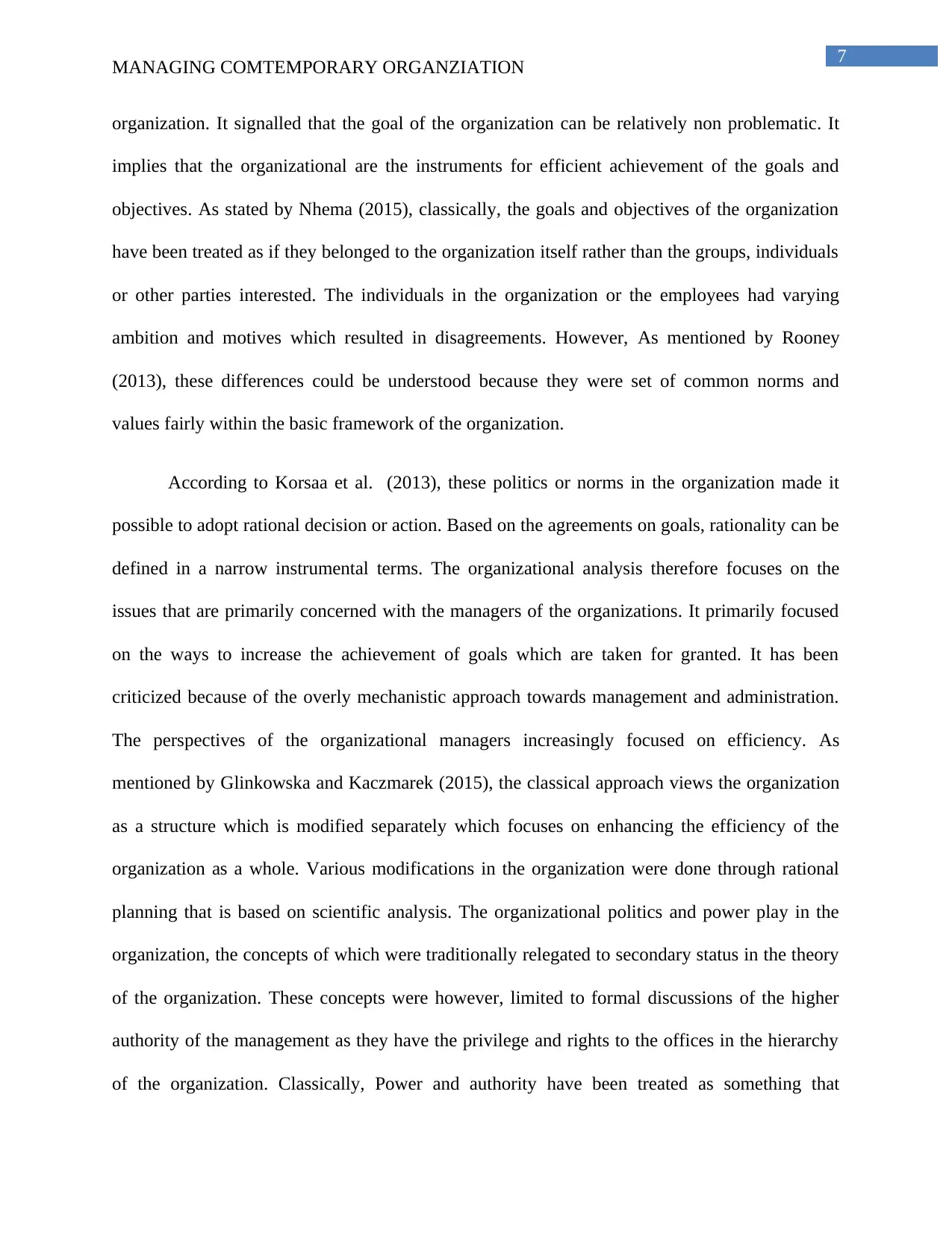
7
MANAGING COMTEMPORARY ORGANZIATION
organization. It signalled that the goal of the organization can be relatively non problematic. It
implies that the organizational are the instruments for efficient achievement of the goals and
objectives. As stated by Nhema (2015), classically, the goals and objectives of the organization
have been treated as if they belonged to the organization itself rather than the groups, individuals
or other parties interested. The individuals in the organization or the employees had varying
ambition and motives which resulted in disagreements. However, As mentioned by Rooney
(2013), these differences could be understood because they were set of common norms and
values fairly within the basic framework of the organization.
According to Korsaa et al. (2013), these politics or norms in the organization made it
possible to adopt rational decision or action. Based on the agreements on goals, rationality can be
defined in a narrow instrumental terms. The organizational analysis therefore focuses on the
issues that are primarily concerned with the managers of the organizations. It primarily focused
on the ways to increase the achievement of goals which are taken for granted. It has been
criticized because of the overly mechanistic approach towards management and administration.
The perspectives of the organizational managers increasingly focused on efficiency. As
mentioned by Glinkowska and Kaczmarek (2015), the classical approach views the organization
as a structure which is modified separately which focuses on enhancing the efficiency of the
organization as a whole. Various modifications in the organization were done through rational
planning that is based on scientific analysis. The organizational politics and power play in the
organization, the concepts of which were traditionally relegated to secondary status in the theory
of the organization. These concepts were however, limited to formal discussions of the higher
authority of the management as they have the privilege and rights to the offices in the hierarchy
of the organization. Classically, Power and authority have been treated as something that
MANAGING COMTEMPORARY ORGANZIATION
organization. It signalled that the goal of the organization can be relatively non problematic. It
implies that the organizational are the instruments for efficient achievement of the goals and
objectives. As stated by Nhema (2015), classically, the goals and objectives of the organization
have been treated as if they belonged to the organization itself rather than the groups, individuals
or other parties interested. The individuals in the organization or the employees had varying
ambition and motives which resulted in disagreements. However, As mentioned by Rooney
(2013), these differences could be understood because they were set of common norms and
values fairly within the basic framework of the organization.
According to Korsaa et al. (2013), these politics or norms in the organization made it
possible to adopt rational decision or action. Based on the agreements on goals, rationality can be
defined in a narrow instrumental terms. The organizational analysis therefore focuses on the
issues that are primarily concerned with the managers of the organizations. It primarily focused
on the ways to increase the achievement of goals which are taken for granted. It has been
criticized because of the overly mechanistic approach towards management and administration.
The perspectives of the organizational managers increasingly focused on efficiency. As
mentioned by Glinkowska and Kaczmarek (2015), the classical approach views the organization
as a structure which is modified separately which focuses on enhancing the efficiency of the
organization as a whole. Various modifications in the organization were done through rational
planning that is based on scientific analysis. The organizational politics and power play in the
organization, the concepts of which were traditionally relegated to secondary status in the theory
of the organization. These concepts were however, limited to formal discussions of the higher
authority of the management as they have the privilege and rights to the offices in the hierarchy
of the organization. Classically, Power and authority have been treated as something that
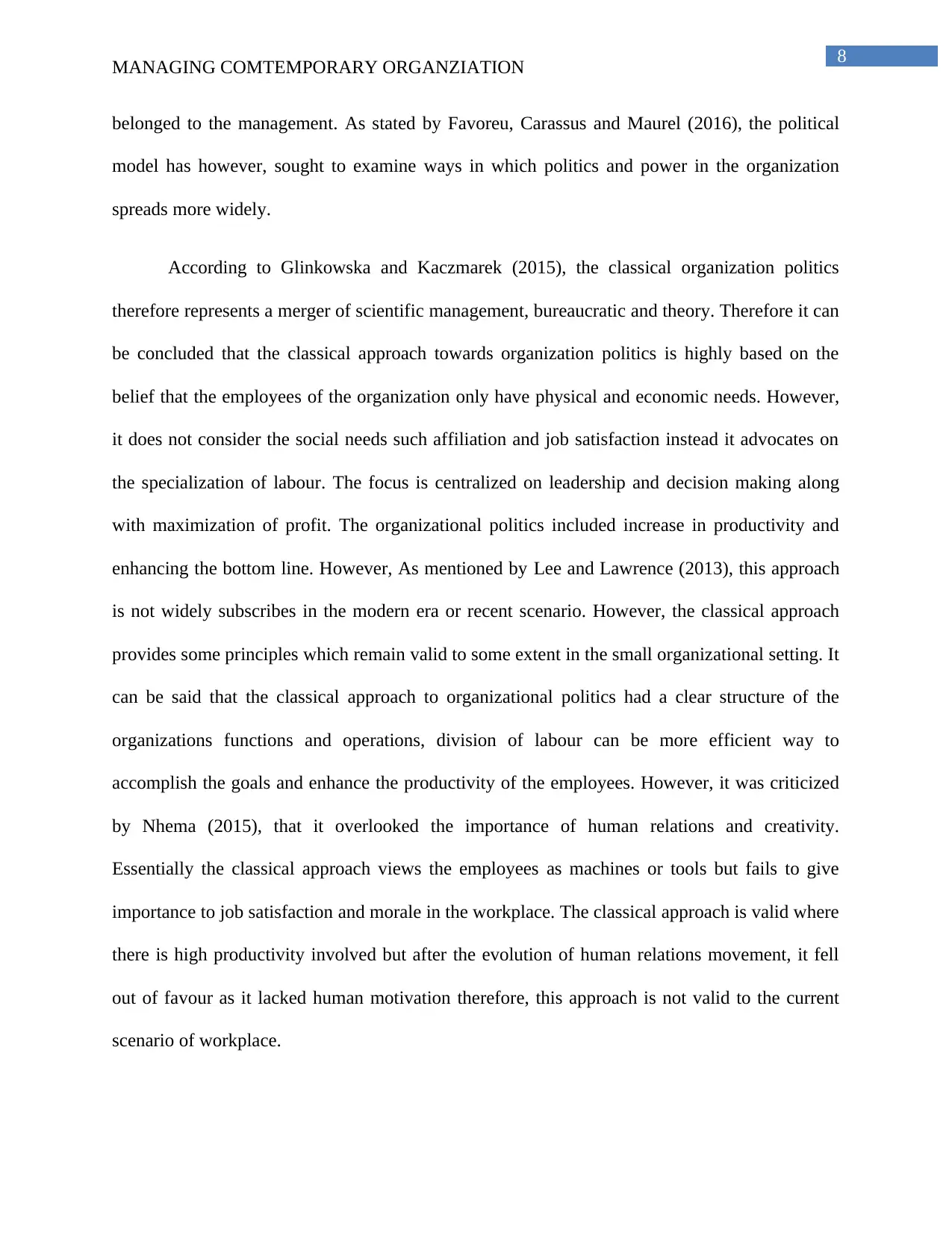
8
MANAGING COMTEMPORARY ORGANZIATION
belonged to the management. As stated by Favoreu, Carassus and Maurel (2016), the political
model has however, sought to examine ways in which politics and power in the organization
spreads more widely.
According to Glinkowska and Kaczmarek (2015), the classical organization politics
therefore represents a merger of scientific management, bureaucratic and theory. Therefore it can
be concluded that the classical approach towards organization politics is highly based on the
belief that the employees of the organization only have physical and economic needs. However,
it does not consider the social needs such affiliation and job satisfaction instead it advocates on
the specialization of labour. The focus is centralized on leadership and decision making along
with maximization of profit. The organizational politics included increase in productivity and
enhancing the bottom line. However, As mentioned by Lee and Lawrence (2013), this approach
is not widely subscribes in the modern era or recent scenario. However, the classical approach
provides some principles which remain valid to some extent in the small organizational setting. It
can be said that the classical approach to organizational politics had a clear structure of the
organizations functions and operations, division of labour can be more efficient way to
accomplish the goals and enhance the productivity of the employees. However, it was criticized
by Nhema (2015), that it overlooked the importance of human relations and creativity.
Essentially the classical approach views the employees as machines or tools but fails to give
importance to job satisfaction and morale in the workplace. The classical approach is valid where
there is high productivity involved but after the evolution of human relations movement, it fell
out of favour as it lacked human motivation therefore, this approach is not valid to the current
scenario of workplace.
MANAGING COMTEMPORARY ORGANZIATION
belonged to the management. As stated by Favoreu, Carassus and Maurel (2016), the political
model has however, sought to examine ways in which politics and power in the organization
spreads more widely.
According to Glinkowska and Kaczmarek (2015), the classical organization politics
therefore represents a merger of scientific management, bureaucratic and theory. Therefore it can
be concluded that the classical approach towards organization politics is highly based on the
belief that the employees of the organization only have physical and economic needs. However,
it does not consider the social needs such affiliation and job satisfaction instead it advocates on
the specialization of labour. The focus is centralized on leadership and decision making along
with maximization of profit. The organizational politics included increase in productivity and
enhancing the bottom line. However, As mentioned by Lee and Lawrence (2013), this approach
is not widely subscribes in the modern era or recent scenario. However, the classical approach
provides some principles which remain valid to some extent in the small organizational setting. It
can be said that the classical approach to organizational politics had a clear structure of the
organizations functions and operations, division of labour can be more efficient way to
accomplish the goals and enhance the productivity of the employees. However, it was criticized
by Nhema (2015), that it overlooked the importance of human relations and creativity.
Essentially the classical approach views the employees as machines or tools but fails to give
importance to job satisfaction and morale in the workplace. The classical approach is valid where
there is high productivity involved but after the evolution of human relations movement, it fell
out of favour as it lacked human motivation therefore, this approach is not valid to the current
scenario of workplace.
⊘ This is a preview!⊘
Do you want full access?
Subscribe today to unlock all pages.

Trusted by 1+ million students worldwide

9
MANAGING COMTEMPORARY ORGANZIATION
References
Algashami, A., Shahri, A., McAlaney, J., Taylor, J., Phalp, K. and Ali, R., 2017, April. Strategies
and Design principles to minimize negative side-effects of digital motivation on teamwork.
In International Conference on Persuasive Technology (pp. 267-278). Springer, Cham.
Anitha, J., 2014. Determinants of employee engagement and their impact on employee
performance. International journal of productivity and performance management, 63(3), p.308.
Boies, K., Fiset, J. and Gill, H., 2015. Communication and trust are key: Unlocking the
relationship between leadership and team performance and creativity. The Leadership
Quarterly, 26(6), pp.1080-1094. Lehmann-Willenbrock, N. and Allen, J.A., 2014. How fun are
your meetings? Investigating the relationship between humor patterns in team interactions and
team performance. Journal of Applied Psychology, 99(6), p.1278.
Crowley, M., Payne, J.C. and Kennedy, E., 2014. Working better together? Empowerment,
panopticon and conflict approaches to teamwork. Economic and Industrial Democracy, 35(3),
pp.483-506.
Favoreu, C., Carassus, D. and Maurel, C., 2016. Strategic management in the public sector: a
rational, political or collaborative approach?. International Review of Administrative
Sciences, 82(3), pp.435-453.
Glinkowska, B. and Kaczmarek, B., 2015. Classical and modern concepts of corporate
governance (Stewardship Theory and Agency Theory). Management, 19(2), pp.84-92.
MANAGING COMTEMPORARY ORGANZIATION
References
Algashami, A., Shahri, A., McAlaney, J., Taylor, J., Phalp, K. and Ali, R., 2017, April. Strategies
and Design principles to minimize negative side-effects of digital motivation on teamwork.
In International Conference on Persuasive Technology (pp. 267-278). Springer, Cham.
Anitha, J., 2014. Determinants of employee engagement and their impact on employee
performance. International journal of productivity and performance management, 63(3), p.308.
Boies, K., Fiset, J. and Gill, H., 2015. Communication and trust are key: Unlocking the
relationship between leadership and team performance and creativity. The Leadership
Quarterly, 26(6), pp.1080-1094. Lehmann-Willenbrock, N. and Allen, J.A., 2014. How fun are
your meetings? Investigating the relationship between humor patterns in team interactions and
team performance. Journal of Applied Psychology, 99(6), p.1278.
Crowley, M., Payne, J.C. and Kennedy, E., 2014. Working better together? Empowerment,
panopticon and conflict approaches to teamwork. Economic and Industrial Democracy, 35(3),
pp.483-506.
Favoreu, C., Carassus, D. and Maurel, C., 2016. Strategic management in the public sector: a
rational, political or collaborative approach?. International Review of Administrative
Sciences, 82(3), pp.435-453.
Glinkowska, B. and Kaczmarek, B., 2015. Classical and modern concepts of corporate
governance (Stewardship Theory and Agency Theory). Management, 19(2), pp.84-92.
Paraphrase This Document
Need a fresh take? Get an instant paraphrase of this document with our AI Paraphraser
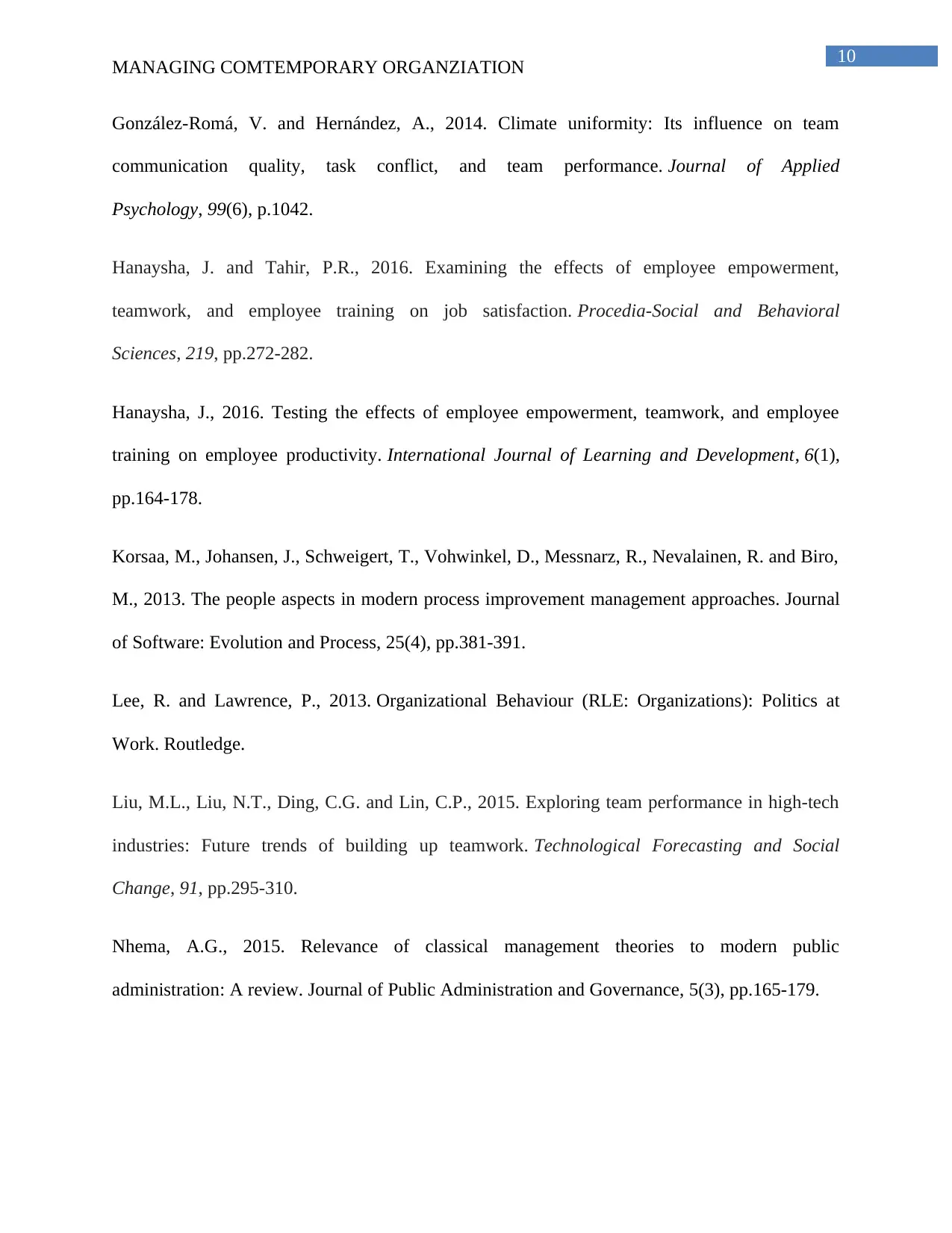
10
MANAGING COMTEMPORARY ORGANZIATION
González-Romá, V. and Hernández, A., 2014. Climate uniformity: Its influence on team
communication quality, task conflict, and team performance. Journal of Applied
Psychology, 99(6), p.1042.
Hanaysha, J. and Tahir, P.R., 2016. Examining the effects of employee empowerment,
teamwork, and employee training on job satisfaction. Procedia-Social and Behavioral
Sciences, 219, pp.272-282.
Hanaysha, J., 2016. Testing the effects of employee empowerment, teamwork, and employee
training on employee productivity. International Journal of Learning and Development, 6(1),
pp.164-178.
Korsaa, M., Johansen, J., Schweigert, T., Vohwinkel, D., Messnarz, R., Nevalainen, R. and Biro,
M., 2013. The people aspects in modern process improvement management approaches. Journal
of Software: Evolution and Process, 25(4), pp.381-391.
Lee, R. and Lawrence, P., 2013. Organizational Behaviour (RLE: Organizations): Politics at
Work. Routledge.
Liu, M.L., Liu, N.T., Ding, C.G. and Lin, C.P., 2015. Exploring team performance in high-tech
industries: Future trends of building up teamwork. Technological Forecasting and Social
Change, 91, pp.295-310.
Nhema, A.G., 2015. Relevance of classical management theories to modern public
administration: A review. Journal of Public Administration and Governance, 5(3), pp.165-179.
MANAGING COMTEMPORARY ORGANZIATION
González-Romá, V. and Hernández, A., 2014. Climate uniformity: Its influence on team
communication quality, task conflict, and team performance. Journal of Applied
Psychology, 99(6), p.1042.
Hanaysha, J. and Tahir, P.R., 2016. Examining the effects of employee empowerment,
teamwork, and employee training on job satisfaction. Procedia-Social and Behavioral
Sciences, 219, pp.272-282.
Hanaysha, J., 2016. Testing the effects of employee empowerment, teamwork, and employee
training on employee productivity. International Journal of Learning and Development, 6(1),
pp.164-178.
Korsaa, M., Johansen, J., Schweigert, T., Vohwinkel, D., Messnarz, R., Nevalainen, R. and Biro,
M., 2013. The people aspects in modern process improvement management approaches. Journal
of Software: Evolution and Process, 25(4), pp.381-391.
Lee, R. and Lawrence, P., 2013. Organizational Behaviour (RLE: Organizations): Politics at
Work. Routledge.
Liu, M.L., Liu, N.T., Ding, C.G. and Lin, C.P., 2015. Exploring team performance in high-tech
industries: Future trends of building up teamwork. Technological Forecasting and Social
Change, 91, pp.295-310.
Nhema, A.G., 2015. Relevance of classical management theories to modern public
administration: A review. Journal of Public Administration and Governance, 5(3), pp.165-179.
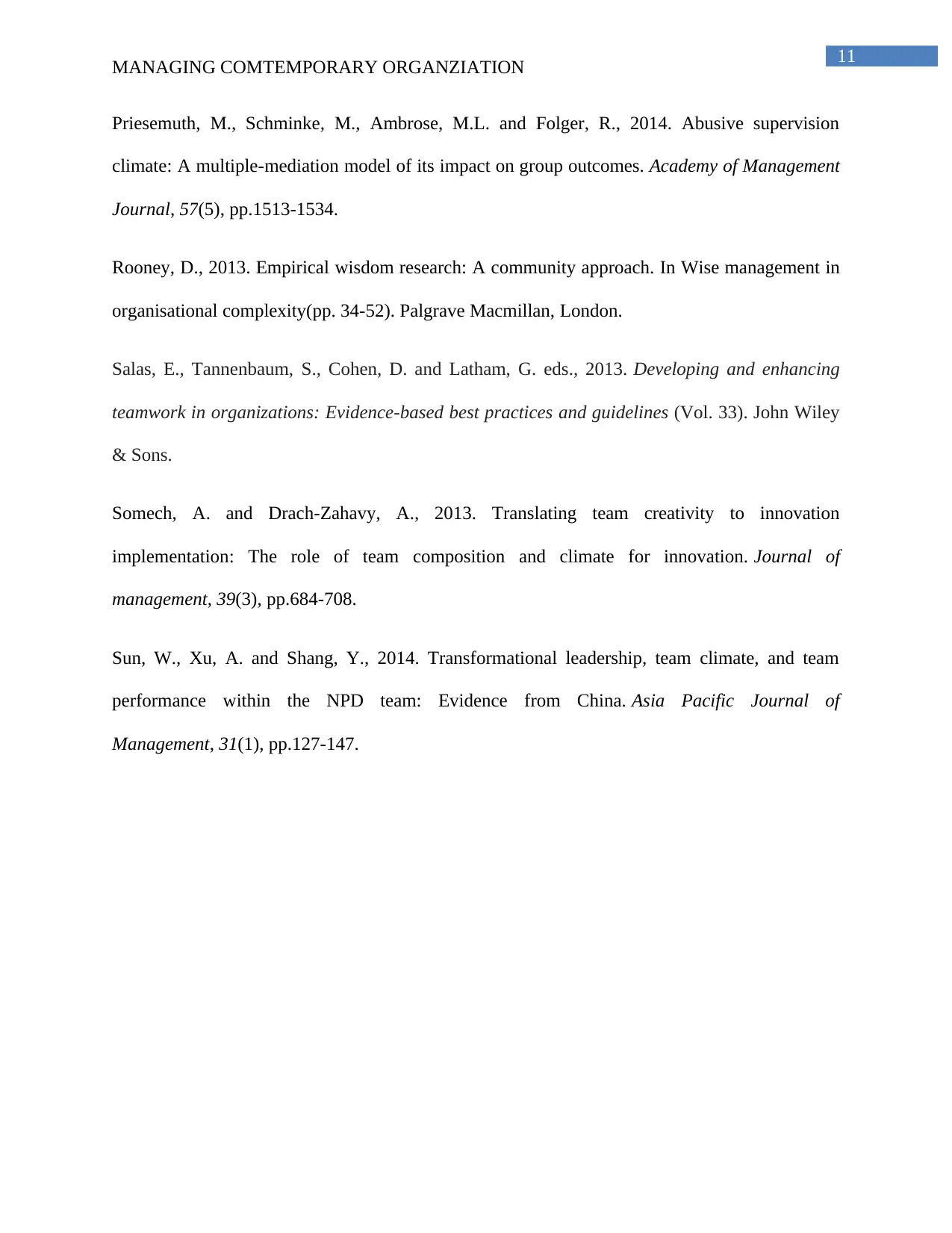
11
MANAGING COMTEMPORARY ORGANZIATION
Priesemuth, M., Schminke, M., Ambrose, M.L. and Folger, R., 2014. Abusive supervision
climate: A multiple-mediation model of its impact on group outcomes. Academy of Management
Journal, 57(5), pp.1513-1534.
Rooney, D., 2013. Empirical wisdom research: A community approach. In Wise management in
organisational complexity(pp. 34-52). Palgrave Macmillan, London.
Salas, E., Tannenbaum, S., Cohen, D. and Latham, G. eds., 2013. Developing and enhancing
teamwork in organizations: Evidence-based best practices and guidelines (Vol. 33). John Wiley
& Sons.
Somech, A. and Drach-Zahavy, A., 2013. Translating team creativity to innovation
implementation: The role of team composition and climate for innovation. Journal of
management, 39(3), pp.684-708.
Sun, W., Xu, A. and Shang, Y., 2014. Transformational leadership, team climate, and team
performance within the NPD team: Evidence from China. Asia Pacific Journal of
Management, 31(1), pp.127-147.
MANAGING COMTEMPORARY ORGANZIATION
Priesemuth, M., Schminke, M., Ambrose, M.L. and Folger, R., 2014. Abusive supervision
climate: A multiple-mediation model of its impact on group outcomes. Academy of Management
Journal, 57(5), pp.1513-1534.
Rooney, D., 2013. Empirical wisdom research: A community approach. In Wise management in
organisational complexity(pp. 34-52). Palgrave Macmillan, London.
Salas, E., Tannenbaum, S., Cohen, D. and Latham, G. eds., 2013. Developing and enhancing
teamwork in organizations: Evidence-based best practices and guidelines (Vol. 33). John Wiley
& Sons.
Somech, A. and Drach-Zahavy, A., 2013. Translating team creativity to innovation
implementation: The role of team composition and climate for innovation. Journal of
management, 39(3), pp.684-708.
Sun, W., Xu, A. and Shang, Y., 2014. Transformational leadership, team climate, and team
performance within the NPD team: Evidence from China. Asia Pacific Journal of
Management, 31(1), pp.127-147.
⊘ This is a preview!⊘
Do you want full access?
Subscribe today to unlock all pages.

Trusted by 1+ million students worldwide
1 out of 12